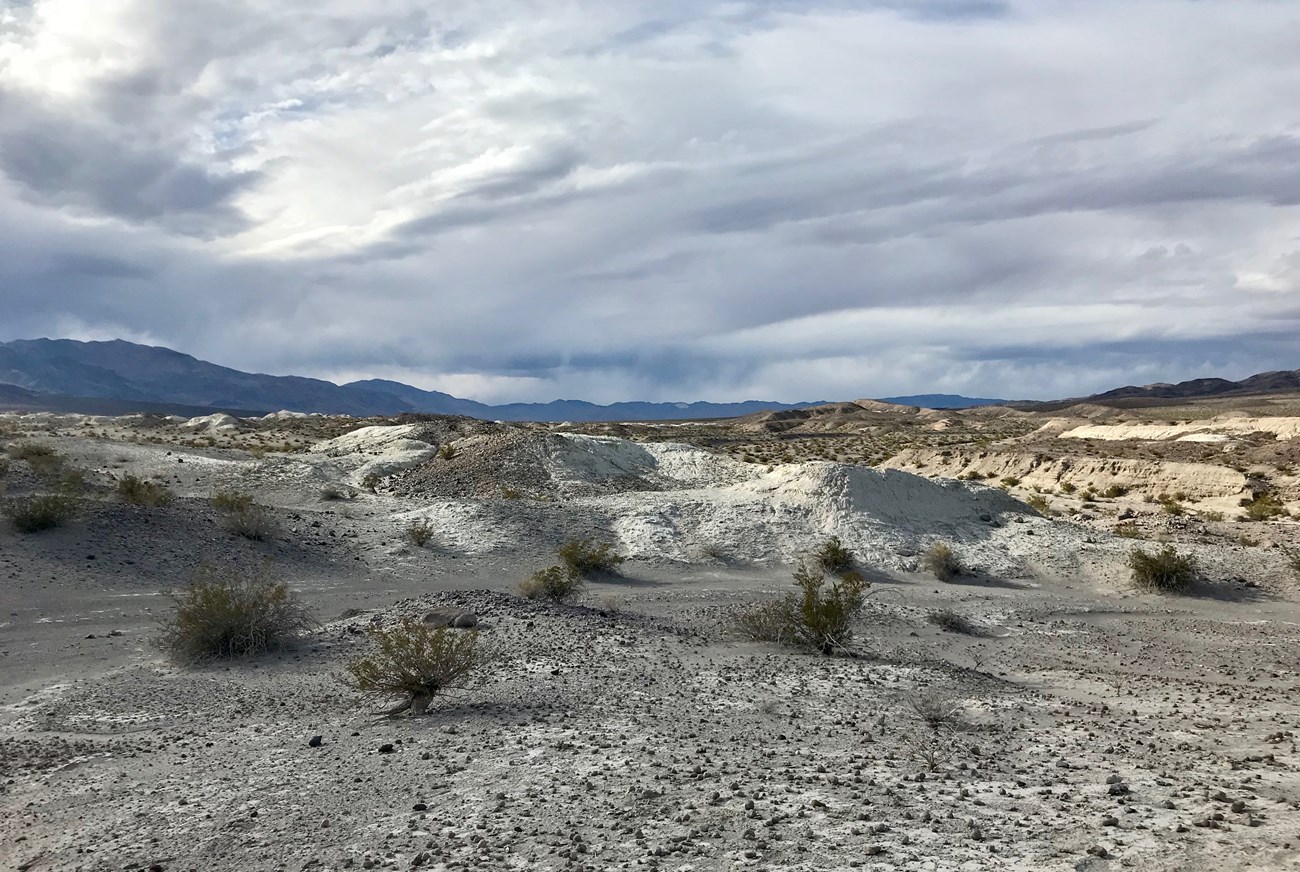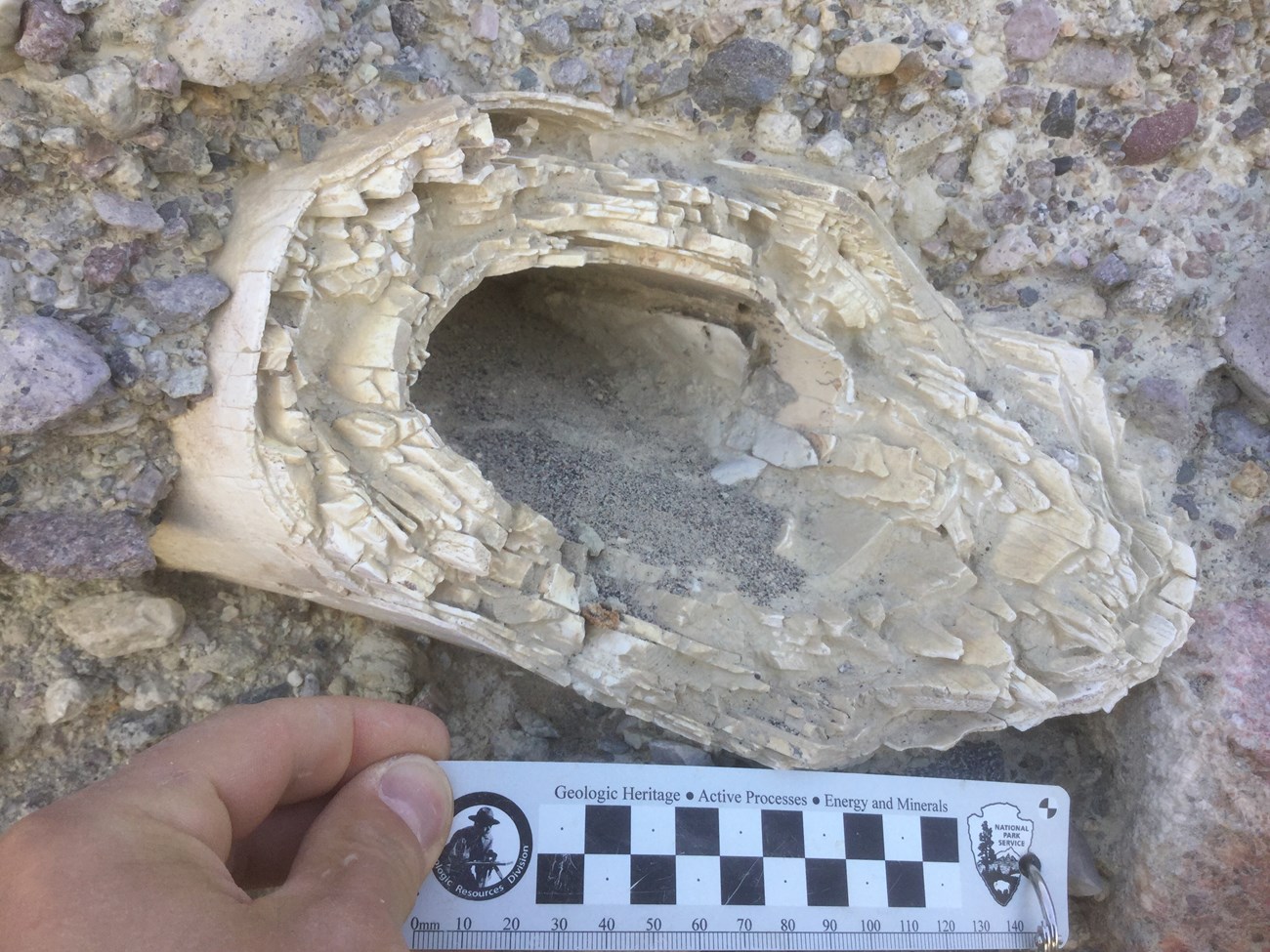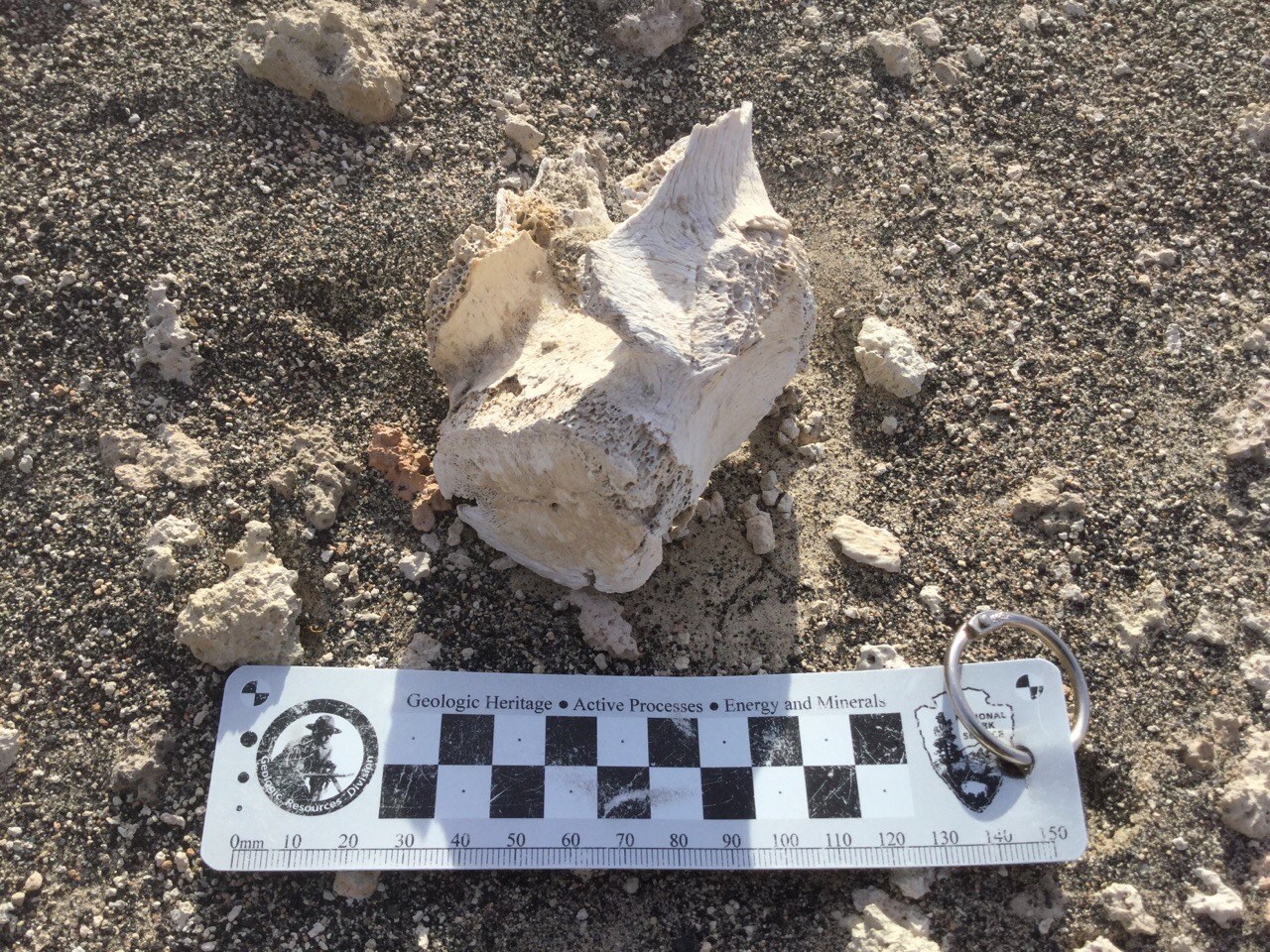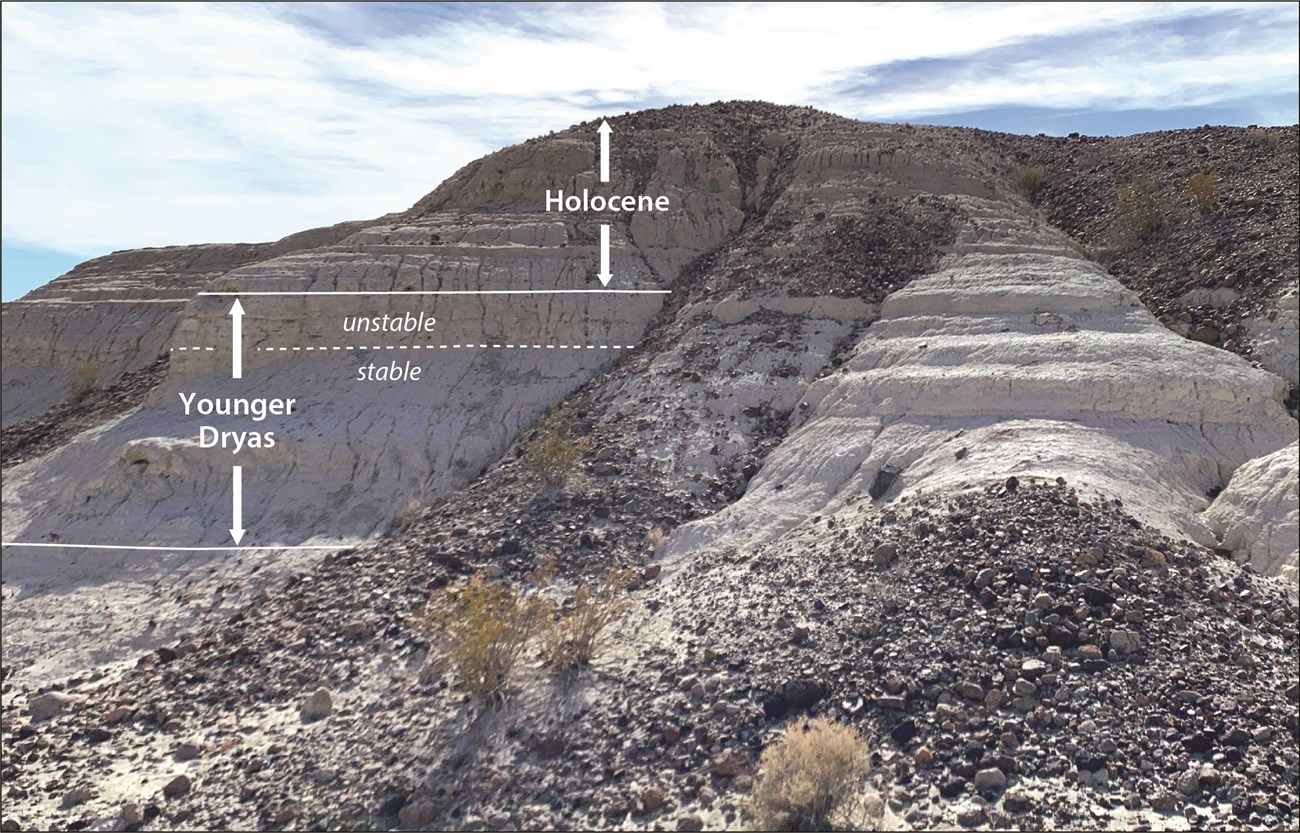Part of a series of articles titled Park Paleontology News - Vol. 12, No. 2, Fall 2020.
Article
Ancient Springs Reveal a Pleistocene Vertebrate Fauna and a 100,000 Year Record of Paleoclimate in Death Valley National Park

Kathleen B. Springer and Jeffrey S. Pigati
U.S. Geological Survey

Photo courtesy of Kathleen Springer
In a place as geologically complex and vast as Death Valley National Park (DEVA), there are ample opportunities for researchers to explore and document little-studied landscapes that represent ancient ecosystems and their evidence of past life. The temporal extent of the rock record in Death Valley is mind-bogglingly ancient, but surprisingly, the Pleistocene vertebrate paleontology history is sparse. Recently, a new study conducted by the U.S. Geological Survey (USGS), the National Park Service (NPS), and academic researchers in a remote wilderness area of the park has unearthed an array of late Pleistocene vertebrate fossils that lived and thrived in an ancient groundwater-fed spring ecosystem that was extremely responsive to climate change over the past 100,000 years.
In the northernmost reaches of DEVA lies the Lake Rogers basin. It is an actively subsiding depression bounded by faults, mountains, and alluvial fans, and drained by the Death Valley Wash. The wash and its tributaries have incised the depositional center of the basin, exposing towering bluffs (up to 20 meters) of an extensive sequence of light-colored, fine-grained deposits referred to informally as the Rogers beds [FIGURE 1]. Vertebrate fossils have been known since the early 1950s when Thomas Clements discovered fossils in the sediments that he named Lake Rogers, with the suggestion that they were Pleistocene based on the inset large mammal fossil taxa of Proboscidea and Equus. And as the name of the basin implies, the sediments were initially interpreted as lake beds. Recently, however, it was proposed that rather than an Ice Age lake, the deposits represent ancient “cienegas” (marshes or wet meadows) formed by groundwater from springs during past wet periods.
New research conducted by Kathleen Springer and Jeff Pigati of the USGS has confirmed that the sedimentary sequence reflects a long-lived spring ecosystem that formed in the valley bottom as elevated groundwater levels responded to changing climate conditions during the late Quaternary. In the arid environments of the American southwest, Death Valley included, springs and wetlands dot the landscape. They exist as biologically productive, yet isolated and fragile ecosystems, supporting diverse and endemic plant and animal communities. Desert wetlands were widespread in the past when effective precipitation was far greater and are commonly preserved in the geologic record as groundwater discharge deposits. Across the region, a reevaluation of sediments that were once thought to be the evidence of pluvial lakes has resulted in their reinterpretation as former desert wetlands, as is the case with the Rogers beds. These spring-fed water sources were magnets for animals, and consequently, these deposits almost always preserve the vertebrate and invertebrate animals that inhabited these ecosystems, and the Rogers beds are no exception.

Photo courtesy of Matt Ferlicchi.
Although paleontologic resources have been known from the Lake Rogers basin for more than half a century, the sedimentary sequence had never been systematically surveyed and its resources assessed. In early 2017, NPS Senior Paleontologist Vincent Santucci arranged for DEVA’s Geoscientists-in the-Parks intern Matt Ferlicchi to begin investigating this remote area for paleontologic resources and he immediately began discovering fossil localities and specimens such as this mammoth tusk [FIGURE 2]. Springer, Pigati, and vertebrate paleontologist Eric Scott of Cogstone Resources, Inc. were also contacted, and the research team was formed. An initial focus of the study is to systematically survey multiple square kilometers of the undulating badland topography of the basin for vertebrate, invertebrate and plant fossils and these efforts have resulted in the discovery of over 250 fossil localities to date. Field identifications indicate the large mammal component of the fauna is dominated by Mammuthus, Equus, and Camelops, along with less common remains of Bison [FIGURES 3-5]. Excavation of the paleontologic resources has not yet commenced, but that activity is planned for future field seasons.

Photo courtesy of Matt Ferlicchi.

Photo courtesy of Matt Ferlicchi.

Photo courtesy of Matt Ferlicchi.
The role of the USGS is to comprehensively investigate the geology and stratigraphic relations of the Rogers beds. This is being accomplished by constructing stratigraphic and chronologic frameworks for the deposits that allow for discrimination of the timing and magnitude of past hydrologic changes, and to place the vertebrate fossils in discrete bins of time. To that end, it was discovered that not only do the deposits contain long records of climatic and hydrologic conditions, they also exhibit distinctive spring hydrologic regimes, including marshes, wet meadows, spring-fed pools and streams. This allows us to place the vertebrate fossils in multiple, discrete spring discharge intervals. Each spring discharge cycle is terminated by stable surfaces and/or erosion, followed by renewed spring activity, as the wetlands waxed and waned in response to climate perturbations. Understanding the temporal and depositional context of the inset faunas represented in the Rogers beds is paramount in determining if, how, and when vertebrate animals responded to these climate stressors in DEVA, which also enables paleontologists to ask the same questions in other areas in the American southwest.
At this juncture in our multi-year study, we have found that the entire Rogers bed depositional sequence spans from ~100,000 to 10,000 years ago. Among the critical observations and crucial lessons learned by the in-depth study of the stratigraphy, chronology, and hydrologic environments of the Rogers beds is that the deposits in DEVA correlate with other known paleowetland deposits elsewhere in the Mojave Desert and southern Great Basin. Not only are the assemblage of animals represented in the faunas regionally similar, but the character of the sediments, and the timing and magnitude of spring ecosystem responses to climate recorded by the Rogers beds, are strikingly similar to those observed in the middle-late Pleistocene Las Vegas Formation in Tule Springs Fossil Beds National Monument (the cornerstone paleowetland record). The recognition that widespread desert wetland ecosystems expanded and contracted in close sync with one another leads to the inevitable conclusion that they were all responding to similar hydroclimate conditions operating over a large geographic region during the late Quaternary. Few archives that proxy for climate, be it ancient lake records, speleothems, etc., have discerned such a cohesive regional climate signal, and at such a high chronologic resolution, as the Mojave Desert paleospring deposits, underscoring their utility in understanding large and small-scale climate fluctuations.
The Rogers beds are incredibly important in understanding these abrupt climate shifts, and have an even more amazing story to tell. One of the most startling examples of abrupt climate fluctuations affecting ecosystems worldwide is the Younger Dryas climate event. As background, the Younger Dryas event spanned from ~12,900 to 11,700 years ago and is considered to be one of the preeminent episodes of abrupt climate change in the recent geologic past. In the American southwest, climate conditions were overwhelmingly cool and wet at this time, and in the North Atlantic and western Europe, exceptionally well dated and complete records from marine and lake core records have shown the Younger Dryas played out as a two-stage phenomenon in which the first several hundred years were characterized by stable, cold/wet conditions whereas the remaining few centuries experienced an unstable, oscillating climate. Half a world away, in the Rogers beds, a remarkable sequence of spring deposits dating to the Younger Dryas mimics this two-stage phenomenon. The sediments cover nearly a square mile and consist of a massive, olive-green silt and clay unit with gastropod shells that represents cold, wet conditions and sustained spring discharge between 13,000 and 12,200 years ago, overlain by alternating organic-rich black mats and oxidized sands that represent unstable conditions that prevailed between 12,200 and 11,600 years ago. The level of detailed hydrologic information at this site is without parallel in spring deposits anywhere in the Mojave Desert, or in fact, in any other paleoclimate proxy record in the terrestrial realm of the Western Hemisphere [FIGURE 6].

Photo courtesy of Kathleen Springer
The future holds great promise for the science gleaned from the Rogers beds: for paleontology, geology and climate science. For the vertebrate paleontology world, the preliminary stratigraphic and chronologic frameworks of the Rogers beds will provide the context of the entombed vertebrate fossils. When collected and fully analyzed, faunal representation and diversity at newly discovered sites such as the Rogers beds will likely provide a baseline to compare against published and unpublished data from nearby localities. Importantly, we hypothesize that the faunal composition and dynamics of the Pleistocene megafauna from DEVA will compare favorably with other vertebrate faunas in the Mojave Desert and southern Great Basin, allowing for a better understanding of faunal diversity, migration patterns, and dispersal events that occurred in the American southwest near the end of the Pleistocene. For climate studies, DEVA’s Rogers beds provide crucially important information of how desert wetland ecosystems respond to abrupt climate change. And finally, this research will continue to augment the rich geologic and paleontologic history of the park and supports science-informed interpretation, management and protection of these nonrenewable resources for generations to come.
Related Links
- Death Valley National Park, California and Nevada—[Geodiversity Atlas] [Park Home]
- NPS—Fossils and Paleontology
- NPS—Geology
Last updated: October 8, 2020
